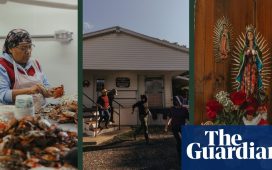Last week, the four artists shortlisted for the Turner prize turned themselves into a four-strong collective in order to win as a group – a move that caused controversy in the press, consternation over social media and a bust-up on Radio 4 between the Guardian’s art critic Adrian Searle and his Sunday Times counterpart, Waldemar Januszczak.
The four artists – Lawrence Abu Hamdan, Helen Cammock, Oscar Murillo and Tai Shani – said they came together “in the name of commonality, multiplicity and solidarity”. In case the politics underpinning the gesture were not obvious, the artists accepted their equal split of the £40,000 prize bearing stickers supporting Jeremy Corbyn and demanding: “Tories out.”
“Historically,” says Ellen Mara De Wachter, author of a book called Co-Art: Artists on Creative Collaboration, “collectives have always been linked with a leftwing outlook. These four artists didn’t just talk the talk, they walked it – and they made a sacrifice. Theirs was a dadaist gesture that exposes how absurd the value system in art is.”

While the Turner prize has never been won in such circumstances before, collectives have previously won and been nominated. Jane Hall of Assemble, a group of architects who came together in 2010 and won in 2015, says collaboration is often born out of political circumstances. “We were the product of austerity. We graduated into a recession. Coming together was about trying to refigure power relationships. Recognising that, at a certain moment, the traditional rules don’t apply any more, so there’s nothing to lose in trying something different.”
Anjalika Sagar – a member of the Otolith Group, who were nominated for the Turner in 2010 – says her decision to work with partner Kodwo Eshun also came from a frustration with the status quo. “It was a reaction against the marketing of the Young British Art thing and kicking against the celebrity obsession of the Cool Britannia moment. It was about being transnational, creating alliances between film groups and linking political ideas transnationally.”
The Fluxus group were arguably the first artists to turn collaboration into a political statement. The 1960s movement, which counted John Cage, Yoko Ono and Nam June Paik among its adherents, sought to play down their individual authorship through a series of anarchic events. Ray Gun Spex, a 1972 “happening” organised by Allan Kaprow featured architectural “environments” by Jim Dine and Claes Oldenburg in which the likes of Kapow and Al Hansen performed. It was no coincidence that Fluxus occurred when the figure of the heroic lone artist – almost always white, male and wielding a paintbrush – was typified by the macho work of Mark Rothko and Jackson Pollock, and fetishised by the art market.
“Under the American capitalist model, the individual ‘genius’ artist became a brand, and there was a great deal of suspicion of collective work,” says De Wachter. “It was dangerous even to operate collaboratively. Because collectivisation was seen as a Soviet thing, artists ran the risk of being branded as ‘red’.”

From the 60s on, groups coalesced around identities ignored by the mainstream art world. Although they produced work independently, AfriCOBRA was formed in Chicago in 1968 by a group of African-American artists with a manifesto to develop art for “the whole family of African people, the African family tree”, because “the wealthy anglos were not buying that day”. New York’s Chinatown also proved to be a wellspring of collaborative enterprise, with collectives of Asian-American artists including Basement Workshop and Epoxy operating out of DIY galleries. In 1971, the former organised the first Chinatown street fair, which featured acupuncture and STD tests, under the banner “unite to fight for our rights”.
More conventional in their output but no less political, Epoxy produced murals, Xerox art and, in 1987, a wall work called 36 Tactics that featured found photographs of world leaders overlaid with texts from Sun Tzu’s The Art of War. The work of Toronto- and New York-based General Idea, founded by Felix Partz, Jorge Zontal and AA Bronson, focused exclusively on the Aids epidemic from 1987 until the deaths of Partz and Zontal from Aids-related illnesses in 1994. In 1991, they produced One Year of AZT/One Day of AZT, a room-size installation mimicking a year’s worth of pills, including five pills the size of coffins.
Such a stance is echoed in the work of the Guerrilla Girls. This anonymous group of female artists came together after an exhibition of international painting and sculpture at the Museum of Modern Art in New York in 1984 that featured just 13 women among the 169 artists. Still working together, the group hide their faces with gorilla masks and use the names of dead female artists as pseudonyms: Frida Kahlo, Ana Mendieta.

In a typically provocative move, last month the group installed an advert on a phone booth outside the newly reopened MoMA demanding that the museum: “Kick Leon Black & Glenn Dubin off its Board immediately, drape the Black & Durbin Galleries in black, & put up wall labels explaining why.” Black, the MoMA chairman, and Dubin, a trustee at the institution, had business relationships with Jeffrey Epstein, who in 2008 was convicted for sex crimes.
Sagar says the Otolith Group operates in a lineage established by the Black Audio Film Collective. Active throughout the 1980s and early 90s, and with members including John Akomfrah and Lina Gopaul, the London-based BAFC produced experimental documentaries and feature films that concentrated on the experiences of the African and Asian diaspora in Britain. “Kodwo and I come from families involved in freedom struggles and in the non-aligned movement,” Otolith’s Sagar says. “We presented ourselves as a black collective in which ‘blackness’ is something ongoing, a place to de-identify from imposed racial categories. We wanted to call ourselves the Otolith Group so people would stop asking us where we were from, or try to define our identities in a reductive way.”
Shared identity underpins much of the desire to work as a group, says curator Charles Esche. “I see what happened in the Turner prize as a gesture that recognises that not everything can be reduced to winners and losers. That’s no dogmatic leftism but something more appropriate to the times in which we find ourselves.”

Esche was part of the committee that chose the Indonesian art collective Ruangrupa as the curators of the next Documenta. As well as being the first from Asia to take the reins of the quinquennial German art festival, they will be the first group to direct the next one in 2022. “I’m convinced they will handle the pressure differently from past curators and ask new questions,” Esche says. “This isn’t only because they are a collective, but because of their experience and cultural empathy – they are less caught in the modernist ego trap that still dominates European cultural politics.”
“The British art world doesn’t really like argument,” says Sagar. “Collectives value argument and discourse – it is inherent to their makeup. This country has a resistance to discourse and theory, to complexity. It is seen as somehow elitist. In 2010, there were some snide comments about our Turner nomination – one journalist branded us pretentious. But we take that as a badge of honour.”
Ruangrupa formed in 2000, two years after the end of Indonesia’s dictatorship, at a time when the country had little art infrastructure. As well as making art, they programme discussion groups, run workshops and produce books. Last year they founded an alternative art school on the outskirts of Jakarta. New Delhi-based artists Raqs Media Collective also see curating as a natural extension of their studio work. In 2015 they directed the Shanghai Biennial and are preparing for next year’s Yokohama Triennial. The group’s Monica Narula says that, although biennials and museums have gradually become accepting of collective working, the art market is slow to catch up.

“Within the money game, the idea of the artist is still such a traditional one, the lonely figure coughing up blood in the garret. When we started showing we were asked, ‘How can you make art collectively?’ People had this attitude that art comes from a single mind to a single hand.”
Of the 385 names represented by the five biggest art galleries in Britain, only six are those of artist groups or duos. Niru Ratnam, a gallerist and former art fair director, says it is not so much the way of working that puts collectors off – though for galleries the increased costs of flying groups of people around the world to attend and install exhibitions will be a factor – but the nature of the work. “Collectives make parts of the commercial art world jumpy. They often form in response to social or political reasons or as a conceptual gesture, which means they are probably going to produce work that is more challenging to sell.”
Yet Stephan Tanbin Sastrawidjaja says that there is a market. His gallery, Project Native Informant, in London, represents three groups: DIS, Shanzhai Biennial and GCC, all of whom, he says, “utilise the methodologies of corporate culture to express themselves”. At the Frieze art fair in 2014, Shanzhai Biennial – the name taken from the term for Chinese counterfeit goods – set up a marketing suite to sell a £32m London property. The eight-strong GCC, who met in the VIP lounge at a Dubai art fair in 2013, have produced daytime TV shows and published a book of their WhatsApp conversations. Two of DIS are in fashion, while the collective has made work for brands. “They produce their criticality from the inside,” Sastrawidjaja says. “I don’t think anyone can operate from outside this culture that engulfs us all.”
Sagar believes that collective working should retain its utopian aims and that it can still pose a threat to the prevailing power structures. “Collectivity is at the heart of what being leftwing is. Collectives contain the threat of the commons, and that scares the right people, that people can come together and produce complex methods of thinking that might work against capitalism.”
Narula concurs that the pull between optimism and frustration that spurred Raqs to form in 1992 still drives them today. “Working together was born out of a certain attitude in politics and life. At the heart of it, we believe collective action could make the world better.”








